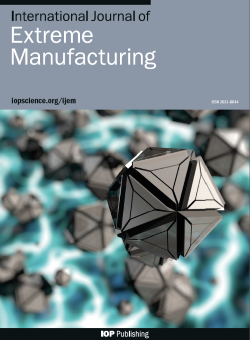Review on Laser Directed Energy Deposited Aluminum Alloys
IF 16.1
1区 工程技术
Q1 ENGINEERING, MANUFACTURING
引用次数: 0
Abstract
The lightweight aluminum (Al) alloys have been widely used in frontier fields like aerospace and automotive industries, which attracts great interest in additive manufacturing to process high-value Al parts. As a mainstream additive manufacturing technique, laser directed energy deposition (LDED) shows good scalability to meet requirements for large-format components manufacturing and repairing. However, LDED Al alloys are highly challenging due to the inherent poor printability (e.g., low laser absorption, high oxidation sensitivity and cracking tendency). To further promote the development of LDED high-performance Al alloys, this review gains a deep understanding of the challenges and strategies to improve printability in LDED Al alloys. The porosity, cracking, distortion, inclusions, elements evaporation and resultant inferior mechanical properties (than laser powder bed fusion) are the key challenges in LDED Al alloys. Processing parameter optimizations, in-situ alloy design, reinforcing particle addition and field assistance are the efficient approaches to improve the printability and performance of LDED Al alloys. The underlying correlations between processes, alloy innovation, characteristic microstructures, and achievable performances in LDED Al alloys are discussed. The benchmarking mechanical properties and primary strengthening mechanism of LDED Al alloys are summarized. This review aims to provide a critical and in-depth evaluation of current progress in LDED Al alloys. The future opportunities and perspectives in LDED high-performance Al alloys are also outlooked.激光定向能沉积铝合金综述
轻质铝(Al)合金已广泛应用于航空航天和汽车等前沿领域,这引起了人们对增材制造加工高价值铝零件的极大兴趣。作为一种主流的快速成型制造技术,激光定向能沉积(LDED)显示出良好的可扩展性,可满足大型部件制造和维修的要求。然而,LDED Al 合金由于其固有的打印性能差(如低激光吸收率、高氧化敏感性和开裂倾向),具有很高的挑战性。为了进一步推动 LDED 高性能铝合金的发展,本综述深入探讨了提高 LDED 铝合金可印刷性的挑战和策略。气孔、开裂、变形、夹杂物、元素蒸发以及由此导致的较差机械性能(与激光粉末床融合相比)是 LDED 铝合金面临的主要挑战。优化加工参数、原位合金设计、添加强化颗粒和现场辅助是提高 LDED 铝合金可印刷性和性能的有效方法。本文讨论了 LDED Al 合金的工艺、合金创新、特征微结构和可实现性能之间的内在联系。总结了 LDED Al 合金的基准机械性能和主要强化机制。本综述旨在对 LDED 铝合金的当前进展进行批判性的深入评估。此外,还展望了 LDED 高性能铝合金的未来机遇和前景。
本文章由计算机程序翻译,如有差异,请以英文原文为准。
求助全文
约1分钟内获得全文
求助全文
来源期刊

International Journal of Extreme Manufacturing
Engineering-Industrial and Manufacturing Engineering
CiteScore
17.70
自引率
6.10%
发文量
83
审稿时长
12 weeks
期刊介绍:
The International Journal of Extreme Manufacturing (IJEM) focuses on publishing original articles and reviews related to the science and technology of manufacturing functional devices and systems with extreme dimensions and/or extreme functionalities. The journal covers a wide range of topics, from fundamental science to cutting-edge technologies that push the boundaries of currently known theories, methods, scales, environments, and performance. Extreme manufacturing encompasses various aspects such as manufacturing with extremely high energy density, ultrahigh precision, extremely small spatial and temporal scales, extremely intensive fields, and giant systems with extreme complexity and several factors. It encompasses multiple disciplines, including machinery, materials, optics, physics, chemistry, mechanics, and mathematics. The journal is interested in theories, processes, metrology, characterization, equipment, conditions, and system integration in extreme manufacturing. Additionally, it covers materials, structures, and devices with extreme functionalities.
 求助内容:
求助内容: 应助结果提醒方式:
应助结果提醒方式:


